
Gloucester Cathedral, formally the Cathedral Church of St Peter and the Holy and Indivisible Trinity, in Gloucester, England, stands in the north of the city near the River Severn. It originated with the establishment of a minster, Gloucester Abbey, dedicated to Saint Peter and founded by Osric, King of the Hwicce, in around 679. The subsequent history of the church is complex; Osric's foundation came under the control of the Benedictine Order at the beginning of the 11th century and in around 1058, Ealdred, Bishop of Worcester, established a new abbey "a little further from the place where it had stood". The abbey appears not to have been an initial success, by 1072, the number of attendant monks had reduced to two. The present building was begun by Abbott Serlo in about 1089, following a major fire the previous year.
William of York was an English priest and twice Archbishop of York, before and after a rival, Henry Murdac. He was thought to be related to King Stephen of England, who helped to secure his election to the province after several candidates had failed to gain papal confirmation. William faced opposition from the Cistercians, who after the election of the Cistercian Pope Eugene III, had William deposed in favour of a Cistercian, Murdac. From 1147 until 1153, William worked to be restored to York, which he achieved after the deaths of Murdac and Eugene III. He did not hold the province long, dying shortly after his return, allegedly from poison in the chalice he used to celebrate Mass. Miracles were reported at his tomb from 1177. He was canonised in 1226.

Leeds Minster, or the Minster and Parish Church of Saint Peter-at-Leeds is the minster church of Leeds, West Yorkshire, England. It stands on the site of the oldest church in the city and is of architectural and liturgical significance. A church is recorded on the site as early as the 7th century, although the present structure is a Gothic Revival one, designed by Robert Dennis Chantrell and completed in 1841. It is dedicated to Saint Peter and was the Parish Church of Leeds before receiving the honorific title of "Minster" in 2012. It has been designated a Grade I listed building by Historic England.
Bossall is a hamlet in North Yorkshire, England with fewer than 100 residents.
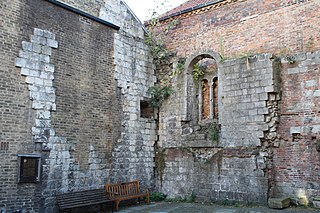
The Norman House is a grade I listed building and scheduled monument in the city centre of York, in England. Although in ruins, it has been described as "York's oldest house", dating from the 12th century.

Duncombe Place is a street in the city centre of York, in England.

Petergate is a street in the city centre of York, in England. It is divided into High Petergate and Low Petergate. The well-known view of the Minster from Low Petergate is described by the City of York Council as "excellent".

Bedern is a street in the city centre of York, in England, which originated as a college for the vicars choral of York Minster.

Precentor's Court is an historic street in the English city of York. Although certainly in existence by 1313, the street does not appear on a map until 1610, and it is not given a name until 1722. It was given its current name exactly a century later.
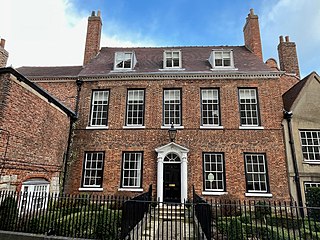
4 Minster Yard is an historic building in the city of York, North Yorkshire, England.

Old Residence is an historic building in the English city of York, North Yorkshire. A Grade II* listed building, located at 6 Minster Yard, at its junction with College Street, the building dates to the early 18th century, but it was raised and reroofed in 1786, as well has receiving a small extension in the late 19th century.

The York Arms is an historic building in the English city of York, North Yorkshire. It was designed by James Pigott Pritchett. Part of a seven-unit row that is a Grade II listed structure dating to 1838, it faces south at 26 High Petergate. These units are sandwiched between early-18th-century properties. The rear of the properties to the north, on Precentor's Court, are also part of the listing. They were originally residences for canons of the adjacent York Minster.
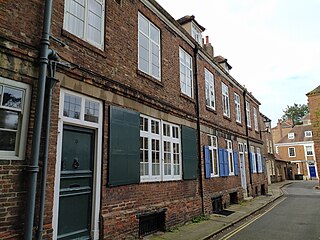
2, 3, 4, and 4a Precentor's Court is an historic row of three buildings in the English city of York, North Yorkshire. Grade II* listed structures, standing on Precentor's Court, the buildings date to around 1710.

5 Precentor's Court is an historic building in the English city of York, North Yorkshire. A Grade II* listed structure, standing on Precentor's Court, the building dates to the early 18th century.

6 and 7 Precentor's Court are an historic pair of buildings in the English city of York, North Yorkshire. Grade II listed structures, standing on Precentor's Court, the buildings date to the mid-19th century, with number 7 having earlier origins. The properties were renovated in the 20th century.
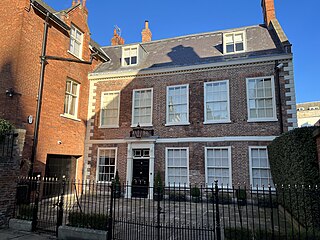
10 Precentor's Court is an historic building in the English city of York, North Yorkshire.

Purey-Cust Lodge is an historic building in the English city of York, North Yorkshire. Now Grade II listed, it dates to 1845. Prior to this date, it was the stone yard for York Minster.

Kirkgate is a street in the city centre of Leeds, in England.
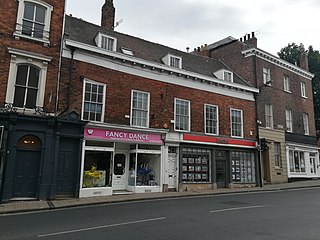
33–37 Micklegate is a historic building in the city centre of York, in England.

Purey-Cust Lodge boundary wall is an historic structure in the English city of York, North Yorkshire. A Grade II listed building, it dates to 1845.




















